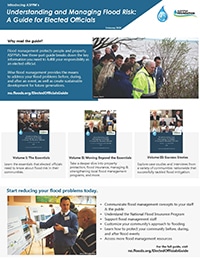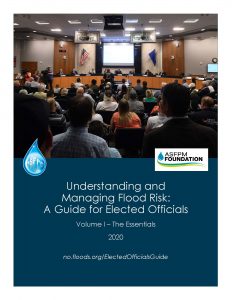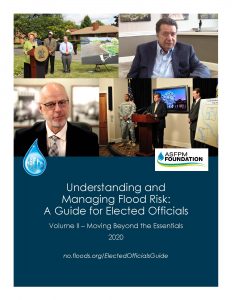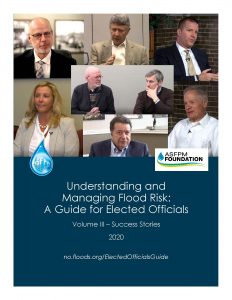 This Guide is written specifically to help elected officials gain a comprehensive understanding of the range of choices that are available as they evaluate how to prepare for – and respond to – flood events in their communities. Elected officials, including mayors, council and commission members, judges and other board members, have a vested responsibility to protect and strengthen their communities. Senior administration and management staff share that responsibility and will benefit from reviewing the same information. In some respects, floodplain management may seem challenging because it has many moving parts. But fundamentally, it’s about protecting people and property. This Guide walks you through the key information you need to fulfill that responsibility.
This Guide is written specifically to help elected officials gain a comprehensive understanding of the range of choices that are available as they evaluate how to prepare for – and respond to – flood events in their communities. Elected officials, including mayors, council and commission members, judges and other board members, have a vested responsibility to protect and strengthen their communities. Senior administration and management staff share that responsibility and will benefit from reviewing the same information. In some respects, floodplain management may seem challenging because it has many moving parts. But fundamentally, it’s about protecting people and property. This Guide walks you through the key information you need to fulfill that responsibility.
As an elected official who has ventured into this Guide, odds are you’re giving some thought to your community’s flood risks, and you are aware of your responsibility to protect public safety, general welfare, and the financial health of your community. Perhaps you and your colleagues are:
- Recovering from a flood and need to know how other elected officials have led their communities after floods
- Realizing your community hasn’t experienced a flood in some time, and want to know more about risk and being prepared
- Meeting with constituents and media after a recent flood
- Preparing to vote on a development proposal and want to better understand the principles of floodplain management, including factors your staff should consider before issuing permits and approvals
- Evaluating the staff capacity and capability with regard to regulating flood hazard areas and preparing for and responding to flood events
- Considering ordinance changes to better guide development to reduce your community’s exposure to flood damage
- Examining options for engineered and natural systems-based projects to mitigate the effects of flooding
- Looking to reduce the flood risk to municipal buildings and your community’s infrastructure
- Considering risks posed to emergency responders during flood events due to concentrations of vulnerable populations and/or access to critical facilities

Now is a good time to learn more about sustainable and resilient floodplain management.
The opportunity to provide protection for your citizens and businesses has never been greater. We must begin to make use of our floodplains in ways that are not only ecologically correct, but also ensure public safety and are acceptable to society as a whole. Wise floodplain management provides the means to address your flooding problems as well as create sustainable development for future generations.
Adapted from ASFPM Overview
This Guide offers background information to help answer your questions and equip you to lead your community to greater resilience. After reading this Guide, you will be able to:
- Communicate the concepts of floodplain management to your colleagues and your constituents
- Understand the importance of your community’s commitment to floodplain management and the National Flood Insurance Program
- Understand the critical responsibilities of the staff member assigned to fulfill the floodplain manager’s responsibilities
- Relay the importance of citizens insuring their structures against flood damage before the next flood
- Make confident critical decisions regarding flood risk and floodplain management to help safeguard residents, businesses, and public infrastructure
- Determine how your community could customize its approach to flooding based on unique characteristics of geography and the watershed, finance, politics and previous successes
- Understand the steps to take before, during and after flood events to protect citizens and help with response and recovery
- Find additional resources to learn more about floodplain management
This Guide consists of three separate volumes. Volume I: The Essentials contains Sections A through C; Volume II: Moving Beyond the Essentials contains Sections D through I; and Volume III: Success Stories contains case studies.
Volume I: The Essentials of this Guide gives you:
- Information on how to begin addressing flooding in your community, in Section A
- Lessons learned to help prepare your community for the next flood, in Section B
- Basic concepts of mitigating flood hazards, in Section B, including an introduction to financial resources that may be available
- Suggestions for communicating with citizens, in Section C
Volume II: Moving Beyond the Essentials of this Guide gives you:
- Basic background information on the concepts involved in managing floodplains, in Section D, Section E, and Section F, which describe the essentials of property protection, understanding flood risk, and flood insurance
- Advice on managing, maintaining and strengthening local floodplain management programs, in Section G and Section H
Volume III: Success Stories of this Guide gives you case studies from a variety of communities nationwide that successfully tackled flood mitigation, including some interviews with the elected officials involved. We hope that their stories encourage you to develop your own personal and legislative approach to managing flood risk and improving public safety and property protection in your community.
This Guide also provides a list of referenced documents, webpages and additional resources. Most of the listed resources were prepared by ASFPM or the Federal Emergency Management Agency. You should also be aware that each state has a National Flood Insurance Program State Coordinating Agency you can contact for guidance. NFIP state coordinators, designated by governors, welcome your inquiries and are there to help resolve your local floodplain management challenges. Some ways that state coordinators support communities are described in Question 41.
 Note: These website pages contain the official published version of Understanding and Managing Flood Risk: A Guide for Elected Officials. Printable .pdf versions are available at the following links: Volume I: The Essentials, Volume II: Moving Beyond the Essentials, Volume III: Success Stories. Please note that this website may be edited in the future with additional updated content but there is no plan to update the .pdf versions produced in February 2020.
Note: These website pages contain the official published version of Understanding and Managing Flood Risk: A Guide for Elected Officials. Printable .pdf versions are available at the following links: Volume I: The Essentials, Volume II: Moving Beyond the Essentials, Volume III: Success Stories. Please note that this website may be edited in the future with additional updated content but there is no plan to update the .pdf versions produced in February 2020.
Interested in sharing this publication with your elected officials? This flyer outlining Understanding and Managing Flood Risk: A Guide for Elected Officials will help them understand the importance of mitigating flood risk in your community.
Common Terminology
ASFPM: The Association of State Floodplain Managers is an organization of professionals involved in floodplain management, flood hazard mitigation, National Flood Insurance Program (NFIP), and flood preparedness, warning and recovery. ASFPM is a respected voice in floodplain management practice and policy in the United States because it represents flood hazard specialists of local, state and federal governments, the research community, the insurance industry and the fields of engineering, hydrologic forecasting, emergency response, water resources and others.
Community: Communities are political subdivisions that have the authority to adopt and enforce land-use regulations. The term usually means incorporated cities, towns, and villages, unincorporated counties, parishes, and boroughs, and authorized tribal organizations.
CRS: FEMA’s Community Rating System is a program that rewards communities that administer floodplain management programs that go above and beyond minimum standards. The benefits of reduced damage are acknowledged by reduced flood insurance premiums for policyholders in communities that participate in the CRS.
FEMA: The Federal Emergency Management Agency is the government agency charged with coordinating the federal government’s role in preparing for, preventing, mitigating the effects of, responding to, and recovering from domestic disasters, whether natural or man-made, including acts of terror. Among other responsibilities, FEMA administers the National Flood Insurance Program.
FIRM: Flood Insurance Rate Maps are official maps of communities on which FEMA delineates Special Flood Hazard Areas.
Floodplain: A floodplain is any area subject to flooding from any source, such as rivers, stream, bayous, lakes, reservoirs, the Great Lakes, the Gulf of Mexico, and the Atlantic and Pacific Oceans. Floodplains include areas subject to the following: catastrophic floods; periodic inundation by heavy rainfall or high tides; storm surges from hurricanes, nor’easters, and other coastal storms; dam failures; nuisance and local drainage flooding; and street flooding from inadequate stormwater drainage systems. Flooding may be exacerbated by riverine and coastal erosion; ground subsidence; sea level rise; changes in rainfall patterns; and development patterns that increase runoff from upland drainage areas.
Floodplain Management: Floodplain management is an overall program of actions taken to reduce flood damage, including such actions as adoption of regulations for development in floodplains, drainage improvements, planning for emergency and evacuations, and helping citizens and businesses understand flood risk and steps that can reduce vulnerability to flooding.
NFIP: The National Flood Insurance Program is a voluntary federal program enabling property owners in participating communities to purchase insurance against flood losses in exchange for community adoption and enforcement of minimum regulations that reduce future flood damage. Definitions used by the NFIP and the minimum land use and control regulations are spelled out in Title 44 of the Code of Federal Regulations, Section 59.1 and Section 60.3.
SFHA: The Special Flood Hazard Area mapped on FIRMs to show areas at risk of flooding from a flood of a specific size (called the 1-percent-annual chance flood) that is the basis for floodplain management in the U.S.
Next section: Volume I: The Essentials ![]()


